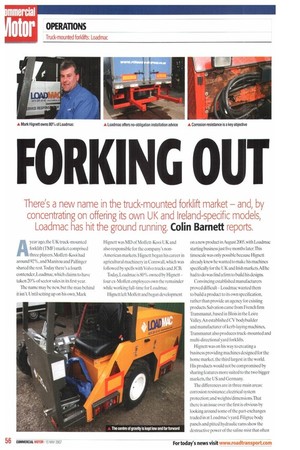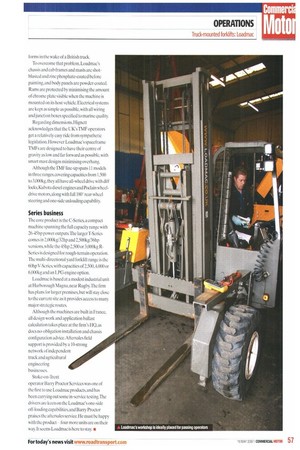FORK NG OUT
Page 56

Page 57

If you've noticed an error in this article please click here to report it so we can fix it.
There's a new name in the truck-mounted forklift market — and, by
concentrating on offering its own UK and Ireland-specific models, Loadmac has hit the ground running. Cohn Barnett reports.
Ayear ago, the UK truck-mounted forklift (IMF) market comprised three players. Moffett-Kooi had around 92°/o, and Manitou and Palfinger shared the rest.Today there's a fourth contender. Loadmac, which claims to have taken 20% of sector sales in its first year.
The name may be new, hut the man behind it isn't. Until setting upon his own, Mark Hignett was MD of Moffett-Kooi UK and also responsible for the company's nonAmerican markets. Hignett began his career in agricultural machinery in Cornwall, which was followed by spells with Volvo trucks and JCB.
Today, Loadmac is 80% owned by Hignettfour ex-Moffett employees own the remainder while working full-time for Loadmac.
Hignett left Moffett and began development on anew product in August 2005, with Loadmac starting business just five months later.This timescale was only possible because Hignett already knew he wanted to make his machines specifically for the UK and Irish markets.All he had to do was find a firm to build his designs.
Convincing established manufacturers proved difficult Loadmac wanted them to build a product to its own specification, rather than provide an agency for existing products. Salvation came from French firm Transmanut, based in Blois in the Loire Valley. An established CV bodybuilder and manufacturer of kerb-laying machines, Transmanut also produces truck-mounted and multi-directional yard forklifts.
Hignett was on his way to creating a business providing machines designed for the home market, the third largest in the world. His products would not be compromised by sharing features more suited to the two bigger markets, the US and Germany.
The differences are in three main areas: corrosion resistance:electrical system protection; and weigh ts/dimensions.That there is an issue over the first is obvious by looking around some of the part-exchanges traded in at Loadmac's yard. Filigree body panels and pitted hydraulic rams show the destructive power of the saline mist that often
forms in the wake of a British truck.
To overcome that problem, Loadmac's chassis and cab frames and masts are shotblasted and zinc phosphate-coated before painting, and body panels are powder-coated. Rams are protected by minimising the amount of chrome plate visible when the machine is mounted on its host vehicle. Electrical systems are kept as simple as possible, with all wiring and junction boxes specified to marine quality.
Regarding dimensions, Hignett acknowledges that the UK's TMF operators get a relatively easy ride from sympathetic legislation. However Loadmac's spaceframe TMFs are designed to have their centre of gravity as low and far forward as possible, with smart mast designs minimising overhang.
Although the TMF line-up spans 11 models in three ranges, covering capacities from 1,500 to 3,000kg, they all have all-wheel drive with diff locks, Kubota diesel engines and Poclain wheeldrive motors,along with full 180 rear-wheel steering and one-side unloading capability.
Series business
The core product is the C-Series, a compact machine spanning the full capacity range with 26-45hp power outputs.The larger T-Series comes in 2,000kg/32hp and 2,500kg/36hp versions, while the 45hp 2,500 or 3,000kg RSeries is designed for rough-terrain operation. The multi-directional yard forklift range is the 60hp V-Series, with capacities of 2.500,4,000 or 6,(XX)kg and an I PG engine option.
Loadmac is based at a modest industrial unit at Harborough Magna, near Rugby.The firm has plans for larger premises, but will stay close to the current site as it provides access to many major strategic routes.
Although the machines are built in France, all design work and application ballast calculation takes place at the firm's HQ,as does no-obligation installation and chassis configuration advice. Aftersales field support is provided by a 10-strong network of independent truck and agricultural engineering businesses.
Stoke-on-Trent operator Barry Proctor Services was one of the first to use Loadmac products, and has been carrying out some in-service testing.The drivers are keen on the Loadmac's one-side off-loading capabilities, and Barry Proctor praises the aftersales service. He must be happy with the product -four more units are on their way. It seems Loadmac is here to stay. •






















































































































































































